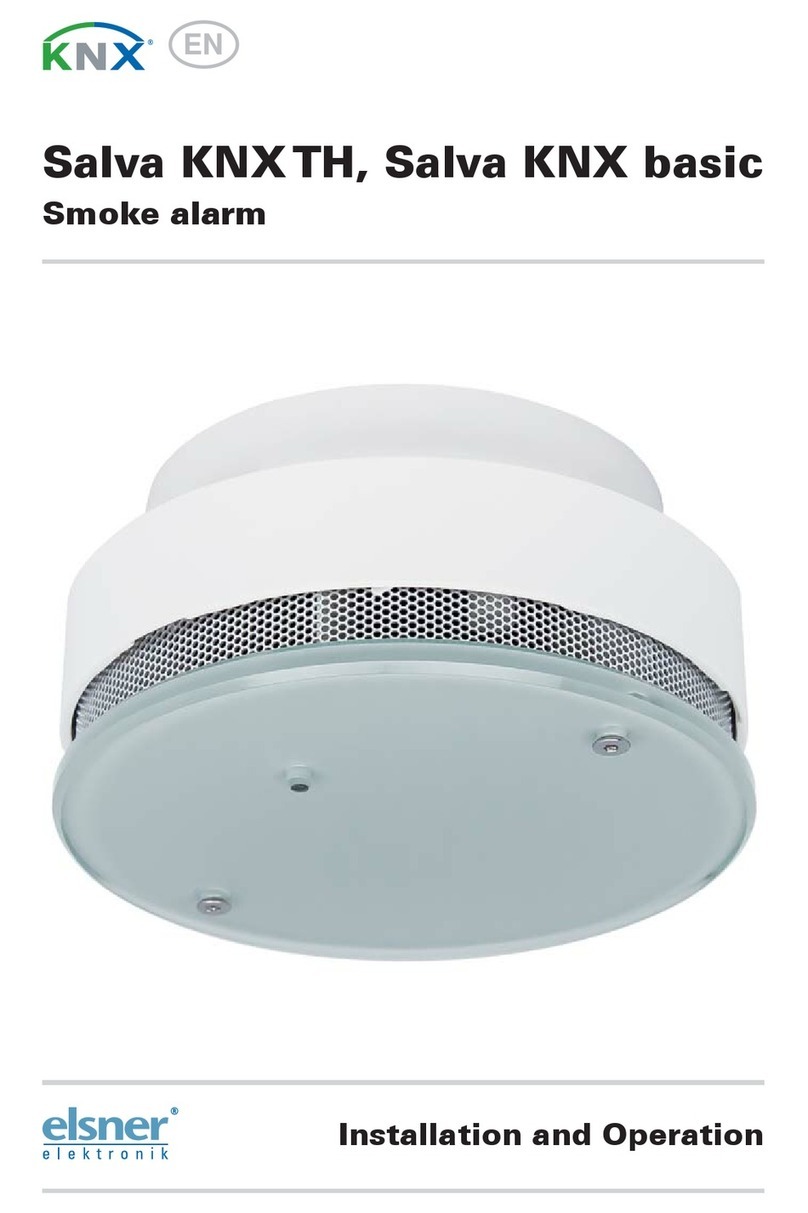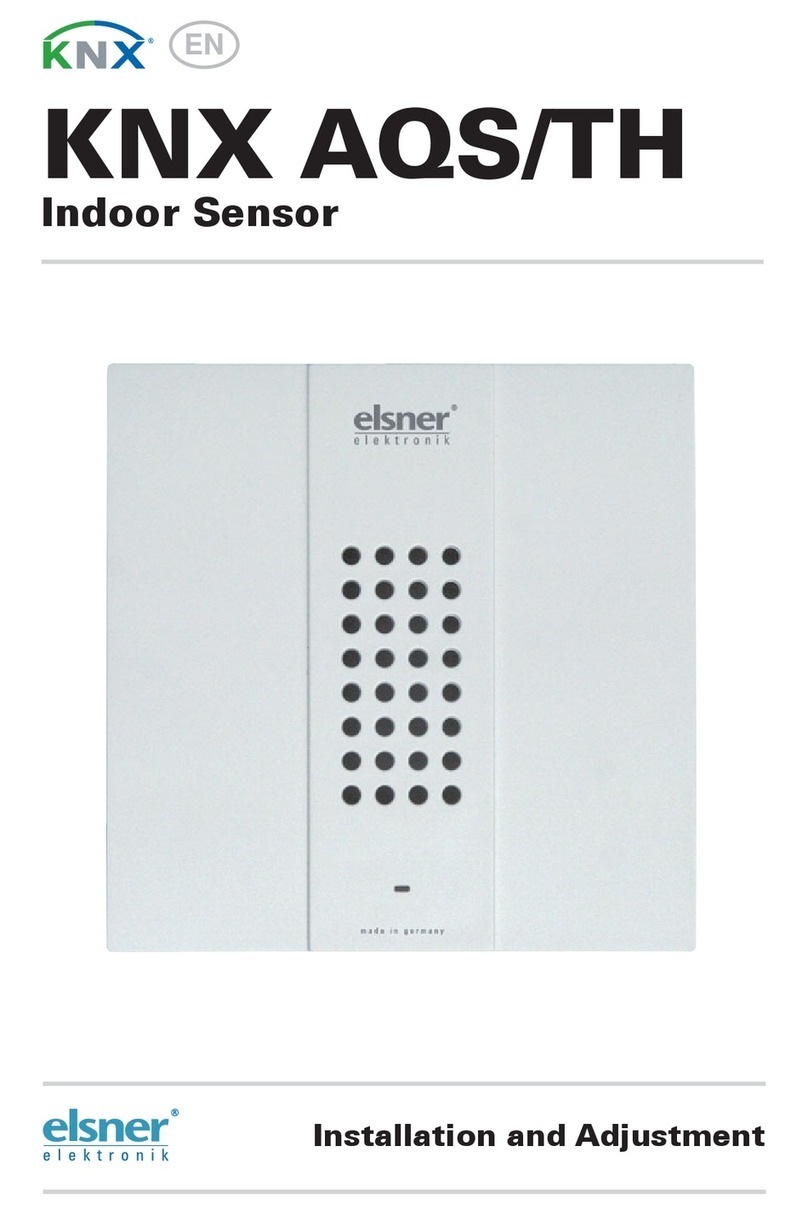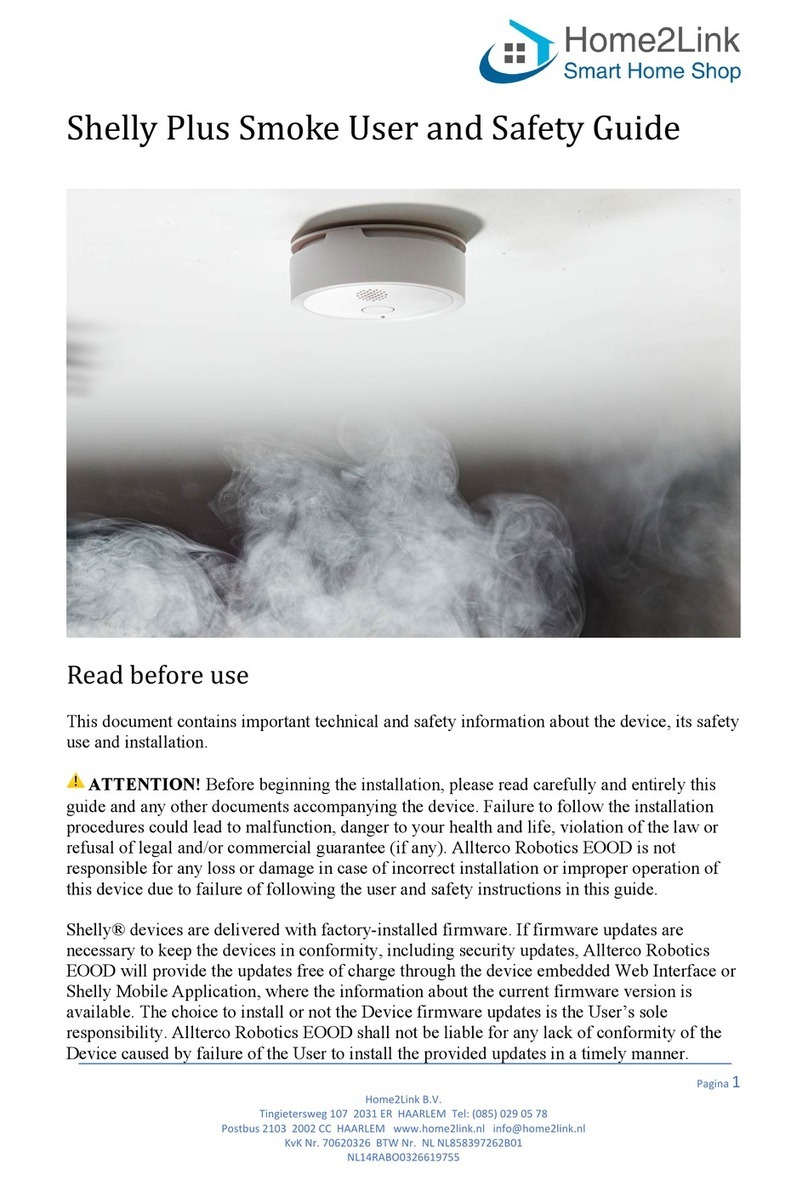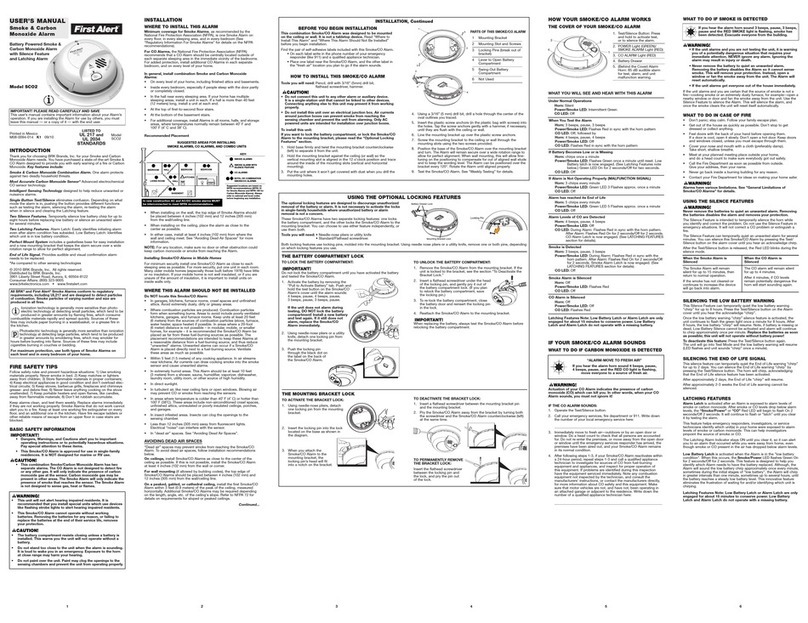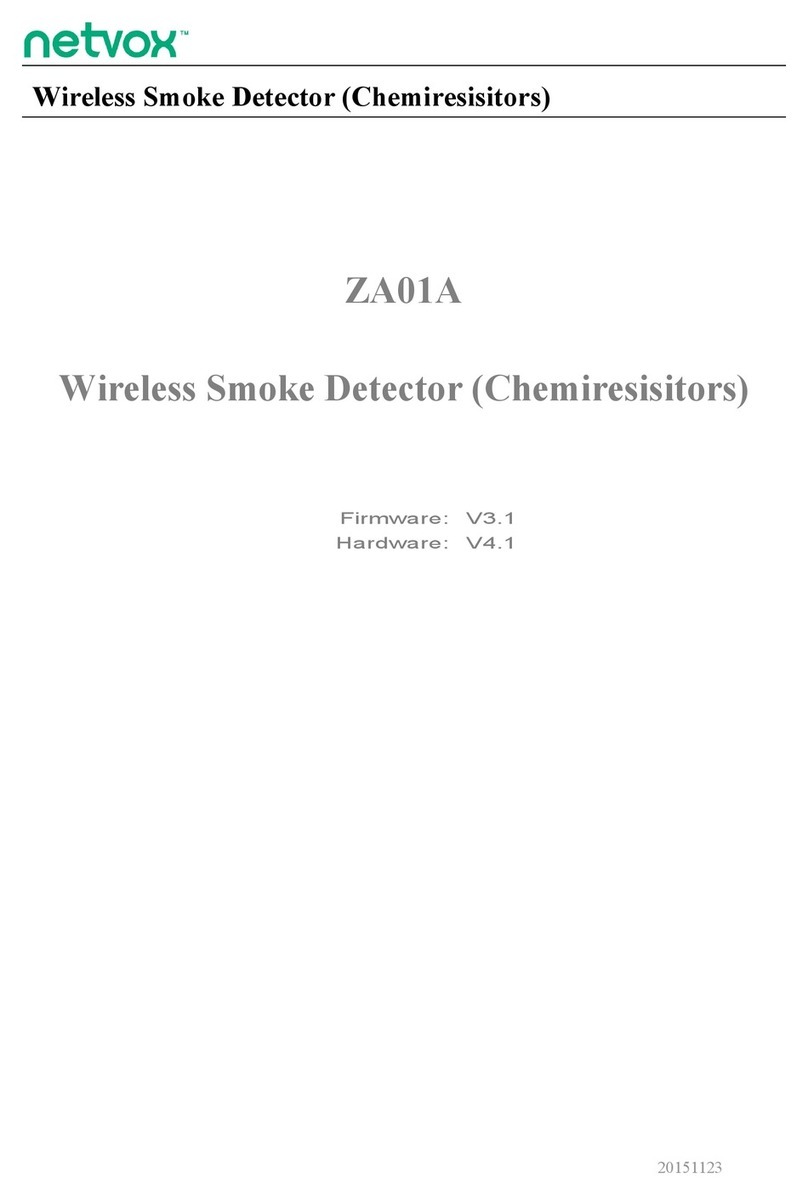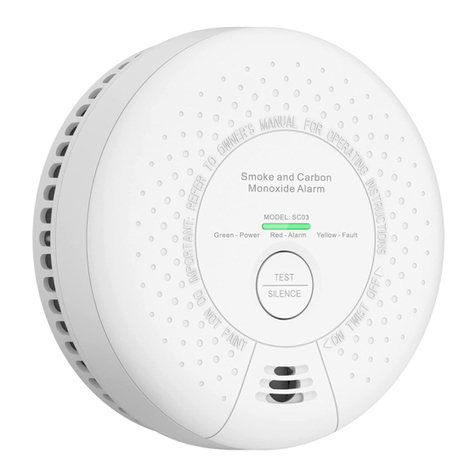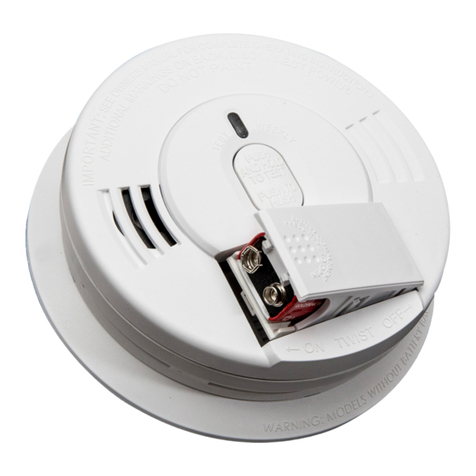elsner elektronik Salva KNX basic User manual

Salva
Smoke alarm
as replacement element for Salva KNX (70405, 70406) or for installation without KNX
Technical specifications and installation instructions
Item number 70409
Elsner Elektronik GmbH Control and Automation Engineering
Sohlengrund 16
Germany Fax +49 (0) 70 33 / 30 945-20 www.elsner-elektronik.de
EN
Technical Service: +49 (0) 70 33 / 30 945-250

2 Description
Smoke alarm Salva • Version: 02.03.2017 • Technical Changes and Errors excepted.
When using the device as replacement element, please see
chapter Use as replacement element for KNX smoke alarms,
page 13.
1. Description
Salva can be used as an independent smoke alarm or as replacement element for the
KNX smoke alarms Salva KNX TH and Salva KNX basic.
The smoke alarm features an automatic evaluation sensor system for early and accu-
rate fire alarms. Alarms are output as a local acoustic signal.
If Salva is used as replacement element for a KNX smoke alarm, the board of the KNX
sensor is inserted into the replacement unit.
Functions:
•Smoke alarm sensors with optical detection based on the scattered light
principle, certified according to EN 14604:2005/AC:2008 and 1172-CPR-150013.
Local acoustic alarm signal output (warning sound at least 85 dB). Local alarm
acknowledgement
• Signalling of smoke alarm
• Smoke chamber pollution measurement and pollution display according to UL
directive
• Power supply via battery (9 V). Lack of battery capacity is signalled optically
and acoustically for 30 days
• High operative safety due to elaborate automatic self-testing of the entire
electronics and separate energy measurement
• Faults signalled locally
• High deceptive alarm immunity due to powerful measuring chamber and
consideration of temperature fluctuations (though no temperature smoke
alarm)
1.0.1. Deliverables
• Sensor (housing with skirting)
•9Vbattery
• 2 screws and dowels for assembly (always use fastening material that is
suitable for the material underneath)
• 2 short slotted screws for mounting the PCB (when used as a replacement
element)
1.1. Technical specifications
Housing ABS, glass
Colour White / Translucent
Assembly Surface mount
Protection category IP 30

3 Installation as separate unit
Smoke alarm Salva • Version: 02.03.2017 • Technical Changes and Errors excepted.
The product conforms with the provisions of EU directives.
2. Installation as separate unit
2.1. Installation notes
Installation, testing, operational start-up and troubleshooting should
only be performed by an electrician.
CAUTION!
Live voltage!
There are unprotected live components inside the device.
• National legal regulations are to be followed.
• Ensure that all lines to be assembled are free of voltage and take
precautions against accidental switching on.
• Do not use the device if it is damaged.
• Take the device or system out of service and secure it against
unintentional use, if it can be assumed, that risk-free operation is no
longer guaranteed.
The device is only to be used for its intended purpose. Any improper modification or
failure to follow the operating instructions voids any and all warranty and guarantee
claims.
After unpacking the device, check it immediately for possible mechanical damage. If it
has been damaged in transport, inform the supplier immediately.
Dimensions Ø approx. 113 mm, height approx. 58 mm
Weight approx. 280 g
Ambient temperature Operation -10…+60°C, storage -10°C … +60°C
Surrounding air humidity max. 93% RH, avoid condensation
Operating voltage 9 V (battery)
Smoke alarm:
Detection principle Tyndall effect (optical)
Alarm display optically (LED red) and acoustically
(signal tone >85 dB(A) / 3 m)
Complies with EN 14604:2005
Max. monitoring area 60 m² to 6 m height
Air velocity max. 20 m/s
Response sensitivity 0.15 dB/m typical
Shelf life for the alarm max. 2 years

4 Installation as separate unit
Smoke alarm Salva • Version: 02.03.2017 • Technical Changes and Errors excepted.
The device may only be used as a fixed-site installation; that means only when assem-
bled and after conclusion of all installation and operational start-up tasks and only in
the surroundings designated for it.
Elsner Elektronik is not liable for any changes in norms and standards which may occur
after publication of these operating instructions.
2.2. Installation location
2.2.1. Equipping the building with smoke alarms
The minimum protection is the installation of smoke alarms in the bedrooms and halls
and/or corridors to ensure that you are woken up during the night in case of a smoke
alarm. If the building has several floors, at least one smoke alarm should be installed
in the hall on every floor. Please refer to DIN 14676 for further installation guidelines.
2.2.2. Positioning and distances
Install the smoke alarm on the room ceiling. If the smoke alarm is installed in the mid-
dle of the room, it has its best detection characteristics.
WARNING!
Mains voltage for in-wall concealed cables!
• If the device is attached by means of screws, first ensure
that there is no power line installed under the assembly point!
Small rooms: If the minimum distance to the wall cannot be maintained, install the
alarm on the wall. Keep a distance of at least 0.50 m and maximum 1 m to the ceiling.
Fig. 1
Minimum equipment
Ideal equipment
Equipment with limitations
Maintain a minimum distance of 50 cm to:
• walls
•lamps
• live wires
≥50 cm

5 Installation as separate unit
Smoke alarm Salva • Version: 02.03.2017 • Technical Changes and Errors excepted.
Rooms with a gallery: Attach an additional alarm underneath the gallery if said gal-
lery is longer and wider than 2 m and has more than 16 m².
Segmented ceilings: If there are separate areas in the ceiling with a depth of more
than 0.20 m and an area of more than 32 m² (e.g. due to beams separating the areas),
install an alarm in each area (on the ceiling or on the beams).
The device is only approved for interior spaces. Do not install in rooms
with temperatures of less than -10°C or more than +50°C! Avoid
condensation.
Do not install in rooms in which a high degree of water vapour is
produced under normal circumstances (e.g. kitchen, bathroom, toilet)!
Do not install near places of fire or open fireplaces!
Do not install near ventilation shafts (e.g. of air conditioning or
circulating air systems)!
Attach the first alarm at a maximum distance
of 7.50 m to the end of the room in long struc-
tures. Distribute at least 3 alarms on 15 m of
corridor. Attach alarms in the middle of cor-
ners and crossroads in the corridor.
Halls and corridors:
≤15 m ≤7,5 m
≤7,5 m
x
0,50 m < x < 1 m
x
< 1 m
0,50 m < x < 1 m
≥1 m
A + B: For pointed and flat gables with a ceiling area of less than 1 m width: Attach
alarms at a minimum distance of 0.50 m and a maximum distance of 1 m to the top.
C: For flat gables with a ceiling area of more than 1 m width: Attach to the middle of
the ceiling like in other rooms.
ABC
Gables:

6 Installation as separate unit
Smoke alarm Salva • Version: 02.03.2017 • Technical Changes and Errors excepted.
Do not paint the smoke alarms!
2.3. Device design
2.3.1. Exterior view
2
Fig. 2
1Skirting
2 Housing with electronics and battery
3 Openings for air circulation
4 Light transmission bar: Red LED for Operating and alarm signals, page 12 and
Push-button for Function test, page 10
3
4
1

7 Installation as separate unit
Smoke alarm Salva • Version: 02.03.2017 • Technical Changes and Errors excepted.
2.3.2. Skirting
2.3.3. Interior view of the housing
2
Fig. 3
1 Battery assembly lock (the housing cannot be closed without a battery)
2 Fastening opening with 1 screw
3 Openings for fastenings with 2 screws (distance 67 mm)
4 Opening for bus cable
3
4
1
Fig. 4
1Battery
1

8 Installation as separate unit
Smoke alarm Salva • Version: 02.03.2017 • Technical Changes and Errors excepted.
2.4. Installing the device
2.4.1. Instructions for assembly and initial start-up
Never expose the device to water (e.g. rain) or dust (e.g. drilling dust). This can damage
the electronics and the sensor system. A relative air humidity of 93% may not be ex-
ceeded. Avoid condensation.
2.4.2. Assembly preparation and skirting assembly
Determine the installation point on the room ceiling. Please observe the instructions in
chapter Installation location, page 4 for this.
BEWARE!
Injury hazard in case of improper fastening!
The device may fall and injure people if it is not fastened properly.
• Observe, the carrying capacity of the wall/ceiling material when
selecting the place of installation.
• Use fixing materials that are suitable for the material underneath.
If you are using the screws and dowels provided, use a 6mm drill to drill holes with a
distance of 67 mm (if you are using two screws for installation). Use the skirting of the
smoke alarm as a stencil. Insert the dowels into the drilling holes.
As an alternative, the skirting of the alarm may be attached to the ceiling with double-
sided adhesive pad (VdS approved). Carefully check the ceiling surface carefully for
lasting carrying and adhesive capacity before using adhesive pads. If necessary, do a
test glueing application. Optimum adhesive power can only be obtained on a clean sur-
face.
Remove the protective foil form one side of the adhesive pad and attach the pad in the
middle of the alarm skirting. Then remove the protective foil on the other side and at-
tach the skirting by firmly pressing it to the ceiling.
Fig. 5
The housing is removed from the skirting by
turning it anti-clockwise.
Fig. 6
In case of replacement: Remove the cover on
the opening for the supply line (1) from the
skirting and thread the cable through it.
Screw the smoke alarm skirting onto the ceil-
ing (2, openings for screws).
2
1

9 Installation as separate unit
Smoke alarm Salva • Version: 02.03.2017 • Technical Changes and Errors excepted.
2.4.3. Inserting the battery
The supply line of the smoke alarm occurs via a 9 V battery.
WARNING!
Danger of explosion in case of improper handling of the battery!
Property damage by battery leakage.
• Do not recharge batteries.
• Do not short-circuit batteries.
• Do not force batteries open or damage them
• Do not bring batteries in contact with fire, water or high
temperatures.
ATTENTION!
Do not use rechargeable batteries or mains units for voltage
supply!
• In case of mains voltage, the device would be out of order
if the mains is out and could not signal any fire.
• The lower rechargeable battery voltage would trigger
a low battery capacity alarm.
2.4.4. Completing the installation
Check if the LED is flashing and conduct a function test.
> Function test, page 10
Fig. 7
Connect the battery (check for correct polari-
ty!) and insert it into the battery compartment.
Fig. 8
Place the housing onto the skirting and fasten
it by turning it clockwise.

10 Maintenance
Smoke alarm Salva • Version: 02.03.2017 • Technical Changes and Errors excepted.
3. Maintenance
In some German federal states, the owner of houses and flats are responsible for the
installation and functioning of smoke alarms according to LBO (State construction
laws) (see www.rauchmelder-lebensretter.de). Maintenance has to be conducted at
least annually and, according to DIN 14676 includes a visual inspection, a function test
and, if required, a battery change. A function test also has to be conducted after any
longer absence, at ,after 1 year at the latest.
The used battery and the device must be disposed of correctly so that
valuable resources may be recycled. Neither the battery nor the device
may be disposed of together with domestic or company waste.
3.1. Function test
BEWARE!
Danger of hearing damage!
During the function test (pressing on the light transmission bar),
a loud, shrill tone is sounded (at least 85 dB).
• Keep a minimum distance of 50 cm between smoke alarm and ear.
1. Conducting a visual inspection:
Check:
• Is the device found at the expected position?
• Are the smoke entry openings clean? - Remove dust if necessary. The device
must not be painted over.
• Is the device free from mechanical damage? - Replace the device if it is
damaged.
2. Conducting a function test:
If the function test is successful, a signal tone sounds. The smoke alarm works proper-
ly. If there is no signal tone, the device is not functioning. In this case, replace the bat-
tery and conduct the function test again. If there is still no signal tone, the device is de-
fect and must be replaced.
Smoke alarms must be replaced with new devices after a maximum
period of 10 years according to DIN 14604.
Fig. 9
Press the light transmission bar for at least 1
second.

11 Maintenance
Smoke alarm Salva • Version: 02.03.2017 • Technical Changes and Errors excepted.
3.2. Replace the battery
The device is supplied with 9 V voltage from a battery. Lack of battery capacity is sig-
nalled optically and acoustically for 30 days.
Check if the LED is flashing and conduct a function test.
> Function test, page 10
3.2.1. Types of batteries
WARNING!
Danger of explosion in case of improper handling of the battery!
• Only replace with a lithium battery type DFK CP-V9Ju.
• Do not use rechargeable batteries or mains units for voltage supply
to ensure a sufficiently high voltage and supply even in case of a
mains outage.
• Do not recharge batteries and do not short-circuit them.
• Do not force batteries open or damage them and do not bring them
into contact with fire, water or high temperatures.
Approved battery type FDK CP-V9Ju
Only use lithium batteries
Average service life approx. 10 years (typical),
under normal conditions as per EN 14604
Fig. 10
Separate the smoke alarm from the skirting
by turning it anti-clockwise.
Fig. 11
Connect the new battery to the smoke alarm
(check for correct polarity!) and insert it into
the battery compartment.
Fig. 12
Place the housing with the new battery onto
the skirting and fasten it by turning it clock-
wise.

12 Device alarm functions
Smoke alarm Salva • Version: 02.03.2017 • Technical Changes and Errors excepted.
The used battery and the device must be disposed of properly so that
valuable resources may be recycled. Neither the battery nor the device
may be disposed of together with domestic or company waste.
3.2.2. Serial number
The serial number on the type plate inside the device contains the production data and
device number:
4. Device alarm functions
4.1. Alarm mute (acknowledgement)
In this case, only the LED continues to flash every 10 seconds. After about 10 minutes,
the devices switches back to normal operating mode.
4.2. Alarm memory
An alarm is saved in the device for 24 hours. During this time, the LED briefly flashes
3 times every 43 seconds. The alarm memory can be reset by pressing the light trans-
mission bar (red LED) once.
4.3. Operating and alarm signals
Function / meaning Signal tone Red LED
Normal operating mode
(automatic self-test)
No sound Flashes every 40 seconds
Alarm status Loud interval tone in
0.5 second rhythm
Flashing twice per second
Fault / dirt Short signal tone 3 times
every 40 seconds
LED off
Ser.no. 25111601
Day of production
Month
Year
Device number
Fig. 13
The alarm can be muted by pressing the
flashing light transmission bar.

13 Use as replacement element for KNX smoke
Smoke alarm Salva • Version: 02.03.2017 • Technical Changes and Errors excepted.
5. Use as replacement element for KNX
smoke alarms
2. Disconnect the device from the bus and remove the battery.
Battery exchange display 1x Short signal tone
every 40 seconds
Flashes every 40 seconds
together with the signal
tone
Alarm mute (acknowledge-
ment)
No sound Flashes every 10 seconds
Alarm memory active
(i.e. there was an alarm
state during the previous
24 hours)
No sound Flashes 3 times every 43
seconds
Function test Loud interval tone Flashing twice per second
while the light transmis-
sion bar
is pressed
Function / meaning Signal tone Red LED
Fig. 14
1. The housing is removed from the skirting
by turning it anti-clockwise.
Fig. 15
3. Loosen the two slotted screws that hold
the board.
Fig. 16
4. Pull the board out of the housing
Grasp the circuit board in the area of
the connector so that the sensitive
pins are not bent.

14 Use as replacement element for KNX smoke
Smoke alarm Salva • Version: 02.03.2017 • Technical Changes and Errors excepted.
6. Connect the device to the bus again.
7. Insert the battery.
9. Check if the LED is flashing and conduct a function test.
> Function test, page 10
Note:
After the bus voltage has been applied, the device will enter an initialisation phase last-
ing a few seconds. During this phase no information can be received or sent via the
bus.
Fig. 17
5. Insert the board into the replacement ele-
ment. The plug-in connection must be
closed again.
Screw the board onto the spacers.
Fig. 18
8. Place the housing onto the skirting and
fasten it by turning it clockwise.
This manual suits for next models
3
Table of contents
Other elsner elektronik Smoke Alarm manuals
Popular Smoke Alarm manuals by other brands
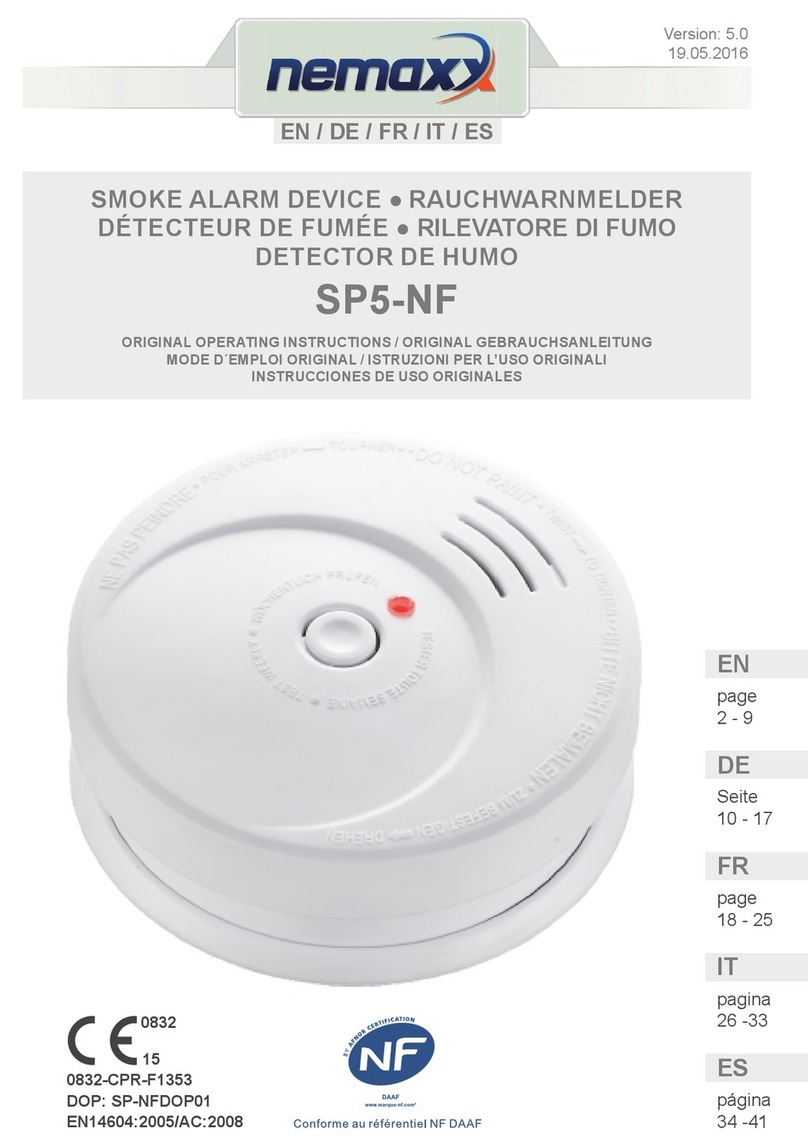
Nemaxx
Nemaxx SP5-NF Original operating instructions
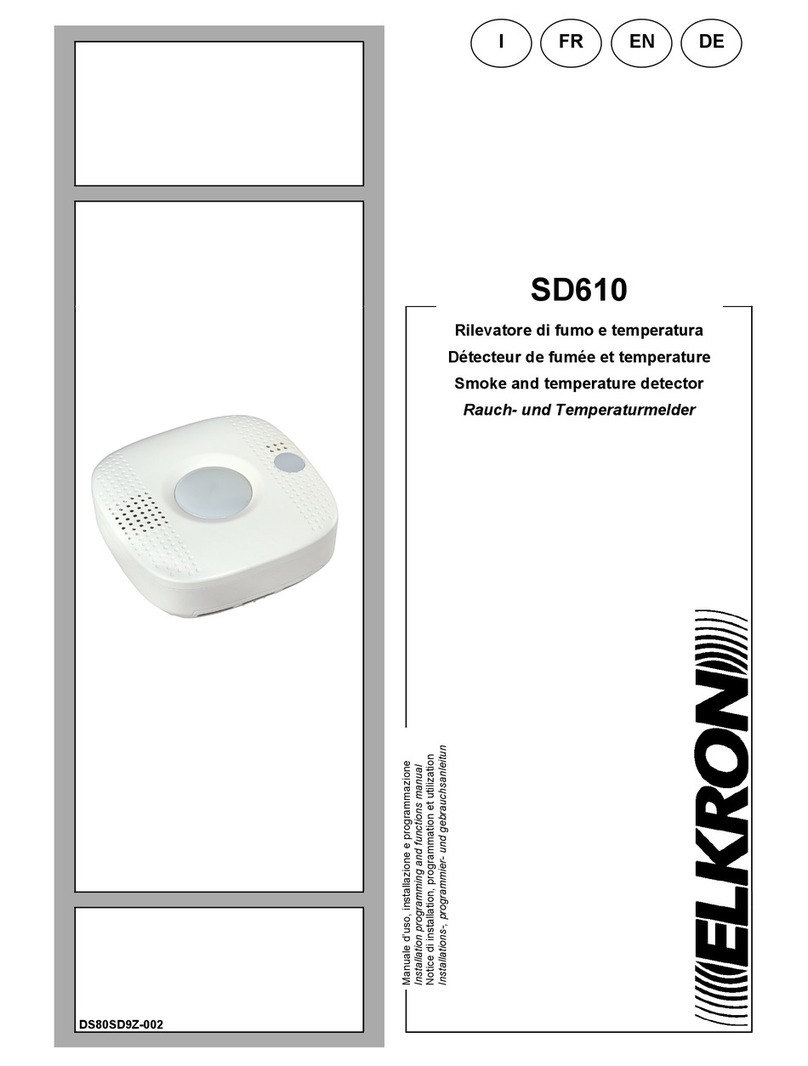
Elkron
Elkron SD610 Installation, programming and functions manual
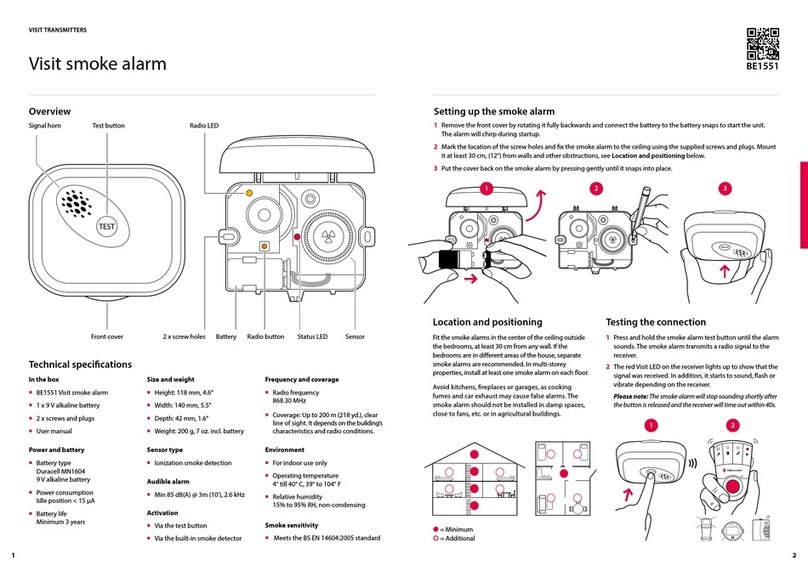
Bellman & Symfon
Bellman & Symfon VISIT BE1551 user guide
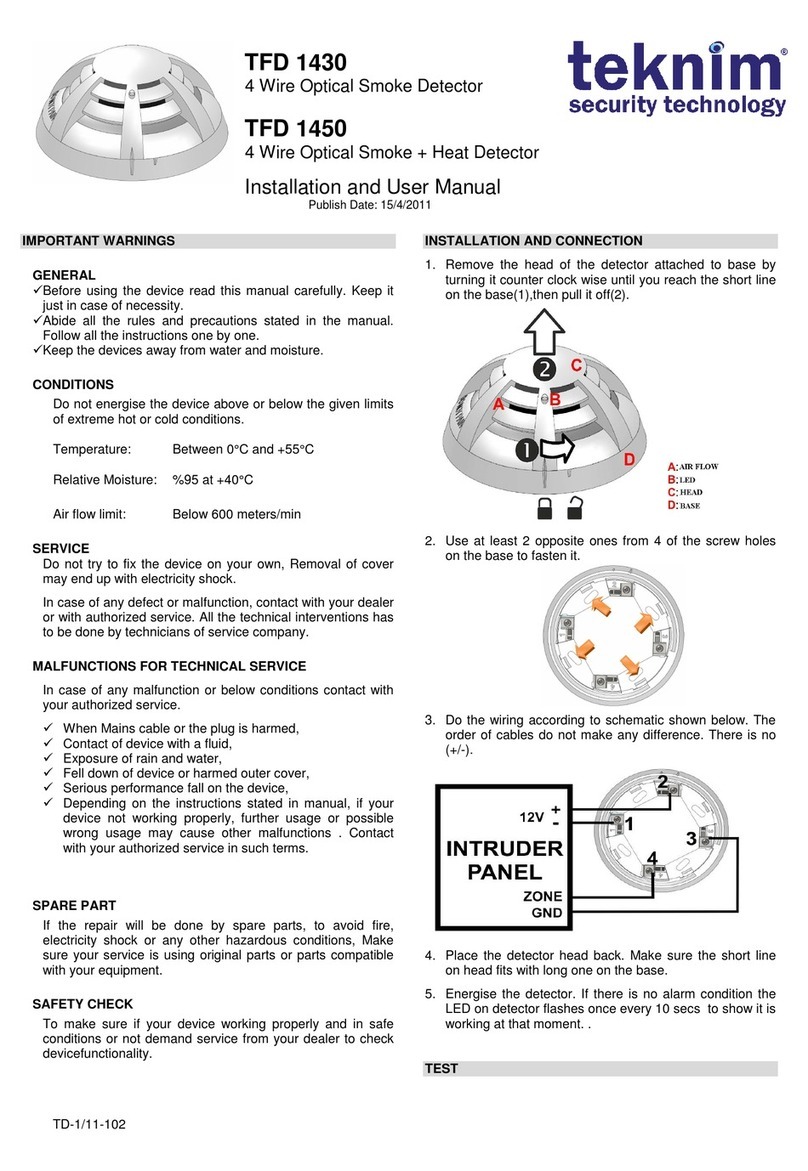
Teknim
Teknim TFD 1430 Installation and user manual
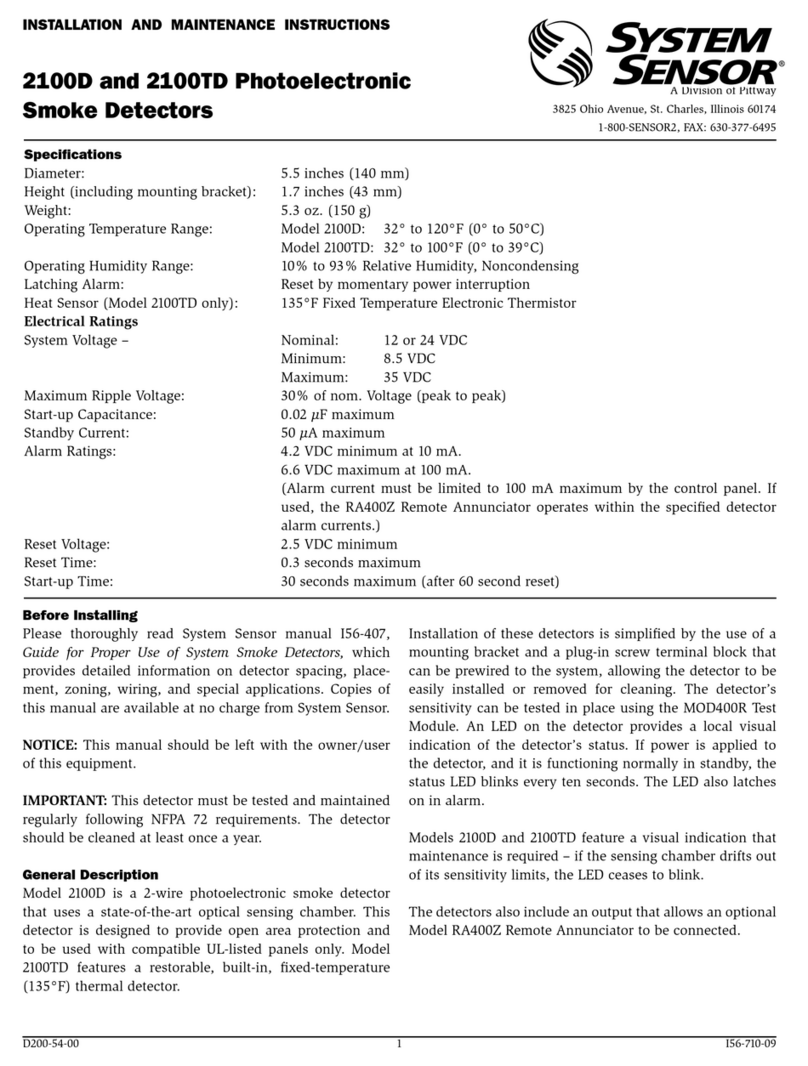
System Sensor
System Sensor 2100D Installation and maintenance instructions

Climax
Climax SD-8ZBS-EL user manual
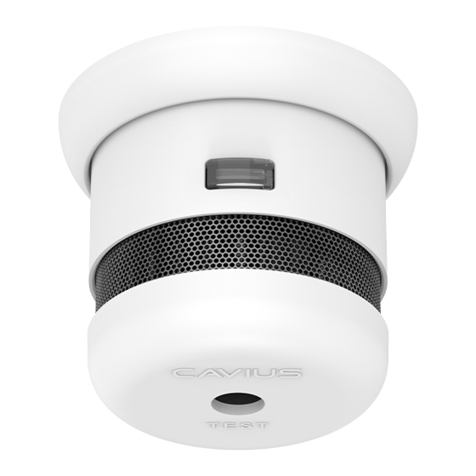
Cavius
Cavius 3002-TK001 user guide
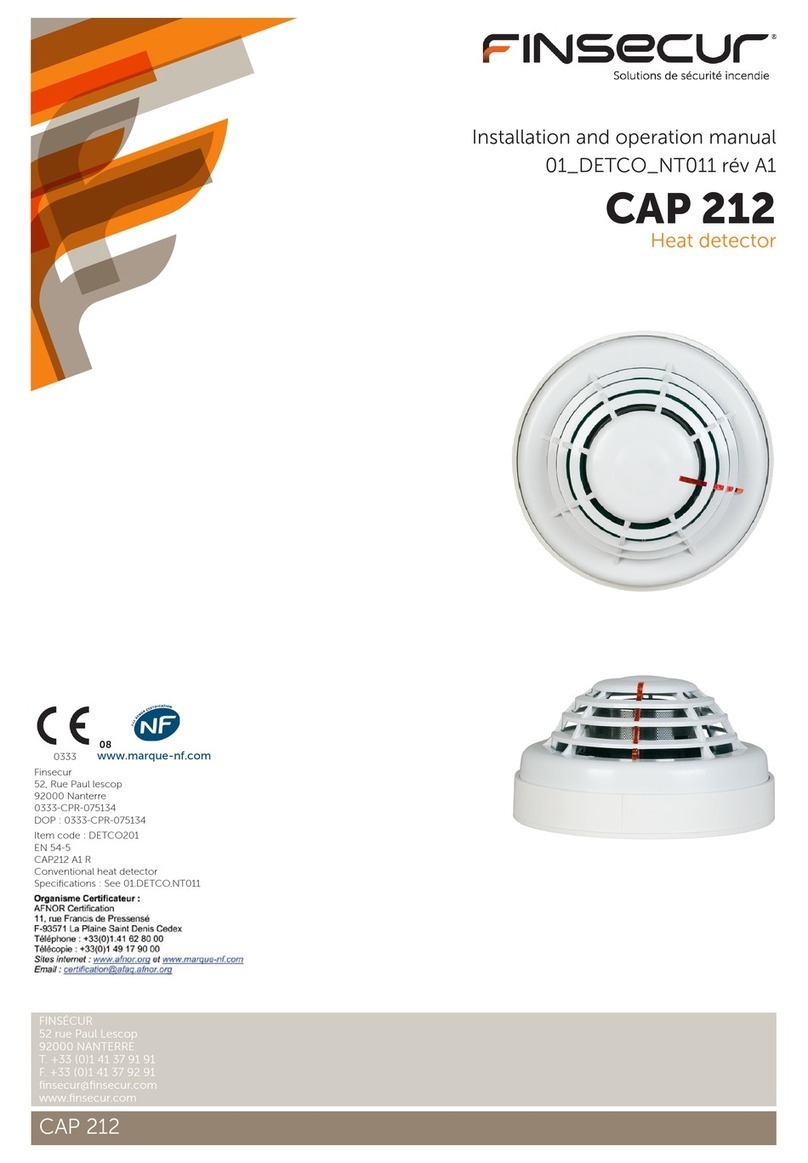
Finsecur
Finsecur CAP 212 Installation and operation manual
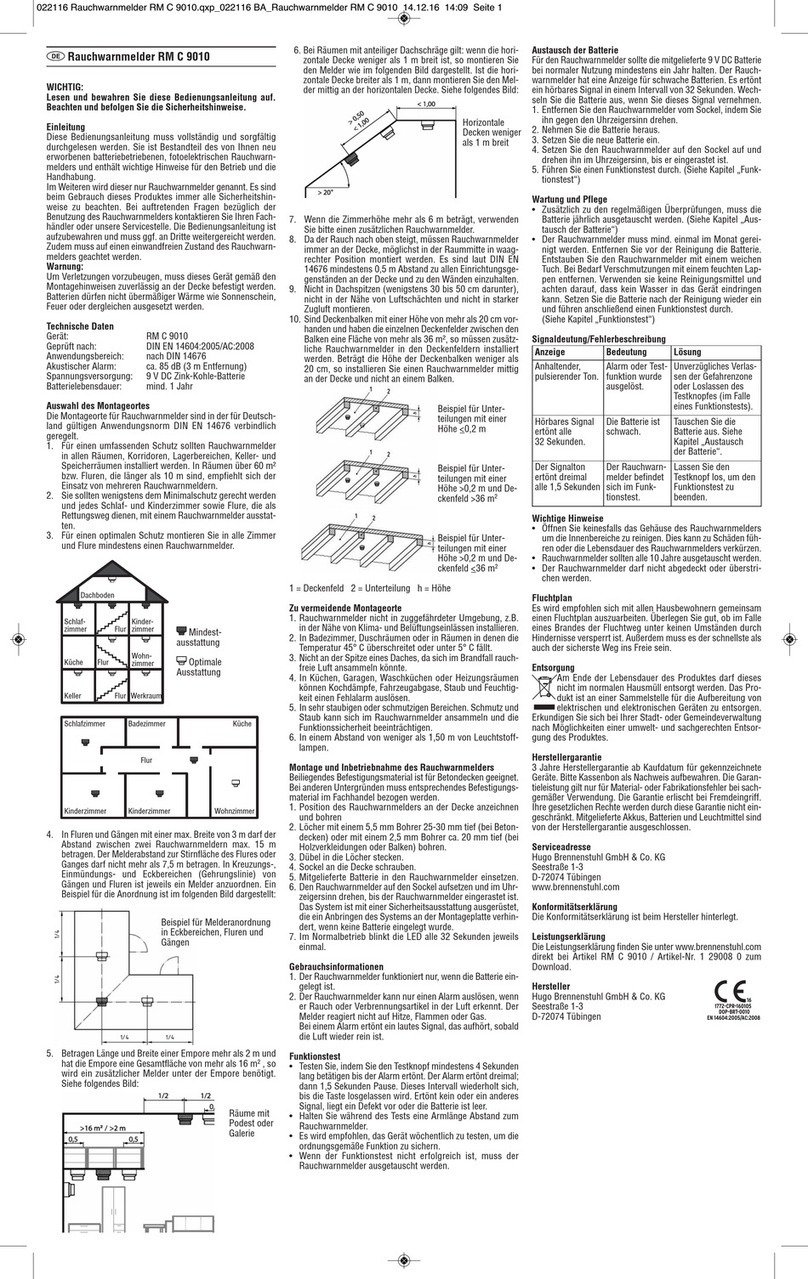
brennenstuhl
brennenstuhl RM C 9010 operating instructions

Ei Electronics
Ei Electronics Easichange Series user manual

Jung
Jung FRWM200 operating manual
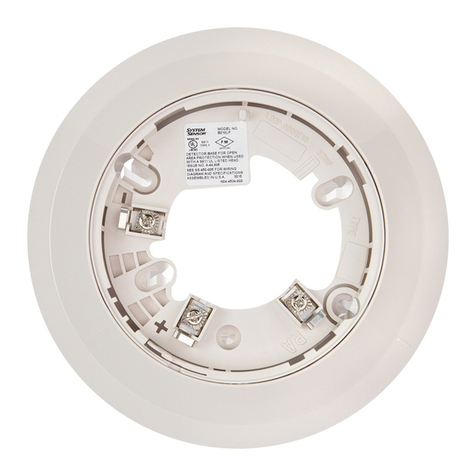
System Sensor
System Sensor B210LP Installation and maintenance instructions
